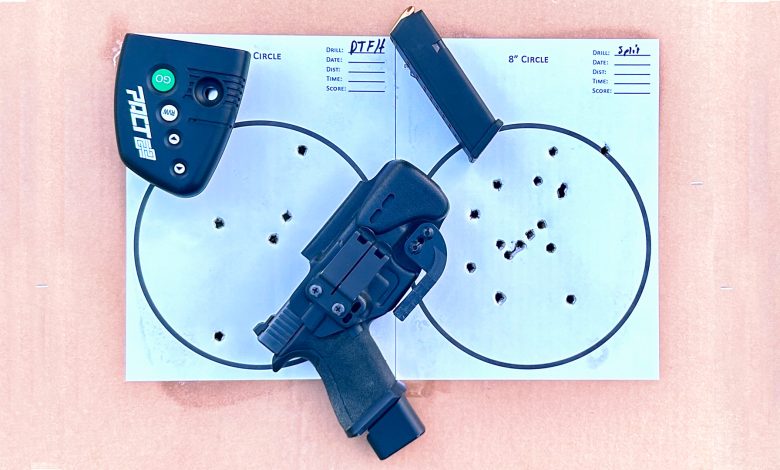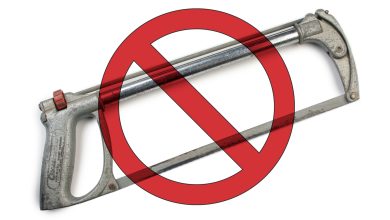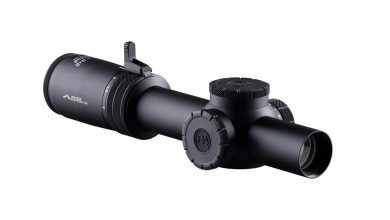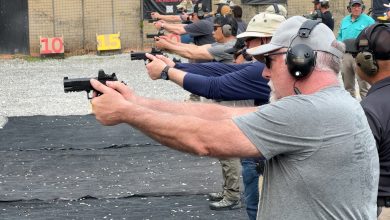Defining Competency Standards For Concealed Carry

As a firearms and self-defense instructor, I’m often asked, “What is the minimum standard of shooting a private citizen should try to meet?” To answer this, I’ve tried to develop goals that were attainable with modest time commitment that would give them the best chance of success in real world defensive shooting. Goal setting is important, because many people believe that simply owning and possessing a firearm makes them “ready.” Certainly there are a great many successful defensive gun uses by people with minimal or no training, but I think any rational and honest person would admit that at least some preparation is far better than no preparation at all. The goal is to answer the question, “How competent am I really, and how do I know that to be true?” So with that in mind, we will tackle the question, “What is a reasonable minimum goal for technical shooting for the armed private citizen?” My opinions below presume basic safe gun-handling and knowledge of the law regarding self-defense as a given. That should be the starting point before we ever worry about becoming good shooters.
Perspective
This topic is always controversial, because any standards one might suggest will seem laughably low for some, and unrealistically high and unattainable for others. My recommended minimum goals are intended to solve the defensive shooting problems we commonly observe in the real world, without having to devote obsessive levels of time and effort commitment that the average person will never be willing or able to commit to. So if you’re a high level shooter who far exceeds these goals then congratulations, but understand not everyone wants to make shooting their primary hobby. The purpose of this article is to share with people easily attainable shooting goals that will enable them to solve the vast majority of the gun problems they could realistically face in their everyday lives. If you’re nowhere near these shooting goals, don’t be discouraged or offended. Just figure out where you are, and begin working to improve if defensive shooting skill is important to you. These are my three primary recommendations based on long periods of study, observation and experience
Draw-To-First Hit
Analysis of real-world defensive shootings strongly suggests that the first participant to get an accurate, solid hit will win the fight. Generally speaking, the baseline definition of a “solid hit” is an approximately 8-inch circle in the high center mass of our target. The ability to rapidly draw and hit such a target from the holster is perhaps the most fundamental defensive shooting skill there is. It is possible your might see trouble coming, but in public we are not justified in drawing our loaded handgun unless we already see an imminent lethal threat. Once we’ve seen that imminent lethal threat, time is of the essence, as is accuracy.
To measure our draw-to-first-hit (DTFH) time there needs to be standard conditions. The standard for measuring DTFH is to set up an IDPA target at seven yards with the goal of hitting the -0 circle which measures 8 inches. You can also substitute any other target which has an 8-ich circle, or an IPSC target which has an A-zone measuring 6 inches wide by 11 inches tall. A shot timer is necessary to shoot this drill, but if you don’t own one there are many serviceable apps available for smart phones. The standard goal I recommend for any citizen who carries a gun out into public is to be able to consistently score a hit in the 8-inch circle at seven yards in less than 2 seconds following the beep of the timer.
In training countless numbers of private citizens, I’ve found this goal is easily obtainable with some consistent dry practice and periodic work on the range. It’s important to note that both elements are required (sub-2 seconds and an accurate hit), but accuracy is more important. You’re better off getting hits in 2.5 or 3 seconds than fast misses. So the goal is to draw as quickly as you can while handling your gun safely and shooting accurately. Obviously, people who train seriously and practice regularly can often far exceed this, with the best shooters far exceeding sub-1 second DTFH. If you want to pursue it to that degree, you’re welcome to do so and I’ll cheer you on (I am a bit faster than sub-2 seconds myself), but this article is to help those looking for goals find something that can be easily maintained with a modicum of training and practice.
Split Times
While drawing rapidly and getting the first accurate hit is probably the single most important defensive shooting skill, it’s doesn’t always solve the problem. Sometimes follow up shots are required. How many will be required? We can’t possibly know that, because in defensive shooting we’re basing everything we do on the attackers actions. As lawfully armed citizens we “shoot to stop.” When facing a lethal attack, our goal is to shoot accurately until the threat has stopped, and then stop shooting.
To achieve this, we need to shoot accurately and quickly – this is an emergency lifesaving measure after all – but not so quickly we can no longer maintain accuracy or are unable to stop shooting as soon we’ve stopped the attack. The time between shots in a string of fire is known in the shooting world as “split times.” Split times are measured by shot timers and give us feedback on how quickly we are shooting. Again, accuracy is primary, both because misses don’t help us solve our problem and because we are legally and morally responsible for any misses we send downrange. This is why misses are also called “unacceptable hits” – all bullets hit somewhere.
The set up for measuring split times is the same as with DTFH: An 8-inch target (IDPA -0 or other, or IPSC A-zone) set up at seven yards. Like with DTFH this distance is chosen as an intermediate distance within the typical distances of defensive gun uses by private citizens. For measuring split times, you can begin with the gun holstered to get repetitions drawing the gun, or you can begin with the gun in hand in the low ready or already on target. The goal is to measure the time between accurate hits, so set up really doesn’t matter. You can begin by firing pairs, and then extend to firing strings of three, four, and so on. The goal I recommend for the average private citizen for purely defensive shooting is .5 second split times while scoring all hits.
This might be considerably faster than your current time between aimed shots. It is considerably slower than what very good shooters are capable of when firing as quickly as they can. Competitive shooters and other high end shooters routinely shoot sub-.2 second splits. If you’re considerably slower than half second splits that is okay, but understand that defensive shooting requires urgency and you need to be able to stop a lethal threat quickly, however many rounds are required.
If you are considerably faster than this then well done, but also ask yourself if you are making a conscious decision to fire each shot, or if you’re making an independent decision with each round to fire. In defensive shooting if the deadly attacker is still in front of us an attacking we are legally justified in shooting again. However, if he’s decided to drop his weapon and flee or has fallen below our sights and muzzle we need enough time to hit the brakes and stop shooting. In my opinion, for real world defensive shooting half second splits are the “Goldilocks” zone for being quick enough to rapidly stop the threat, but deliberate enough that we are under control and measured in our shooting.
Conclusion
There are more baseline metrics of competence in defensive shooting, and I’ll cover more in subsequent articles. For the armed citizen who already understands safe gun-handling and the laws regarding self-defense, and is wondering what to measure and what goals to set, these are great starting points: A rapid draw-to-first-hit and getting their split times down to where they are rapid but measured and under control. If you can meet these two goals, you’ve got the technical shooting skill to solve most of defensive shooting problems you are likely to encounter in the real world.
Read the full article here









